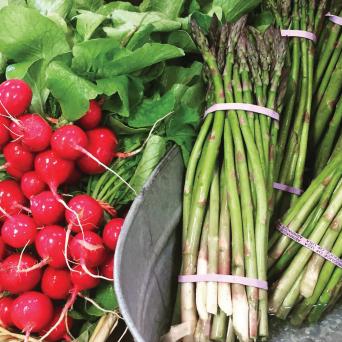
Organize Your Produce to Reduce Your Shopping Trips

I want to keep fresh produce on hand. But in the interest of my and the community’s health, and to lessen the strain on the Co-op, I want to limit my shopping trips right now; my goal is to shop no more than once every two weeks. As a chef, I know it’s possible to stretch fresh produce over two weeks and not feel deprived. To do that, I need to shop wisely. This is my plan:
- Think in terms of my produce’s storage qualities and include both keepers and perishables;
- Make use of every part of the veggie or fruit;
- Handle and store it in ways that lengthen its storage time, and
- Substitute with abandon.
Be sure to follow current guidelines as to how to properly sanitize your purchases. I unpack on the front porch and recycle or dispose of most packing materials so they never enter the house. I’m no fan of soap on my produce, but if you use it, be sure to rinse well. And don’t wash berries or grapes until just before use, or they will spoil quickly.
The How and Where of Produce Storage
Keepers include winter squash, sweet potatoes and potatoes, daikon and other radishes, celery, carrots, citrus, pears, most apples, onions (except sweet), cabbage and lettuce with the roots still attached. I want about half to two-thirds of my purchases to be keepers.
Perishables include asparagus, lettuce, fresh beans, snow peas, fresh squash, eggplant, berries, mushrooms, delicate greens like spinach, herbs, some apples, broccoli, sweet onions, and baby potatoes.
Squash kept on the counter will last for months. Sweet potatoes, potatoes and onions should be stored in a dark, cool dry place such as under-counter cabinets. But keep the onions and potatoes in separate cabinets, or they’ll encourage each other to spoil. The rest and the perishables go in the fridge drawers, but cook baby potatoes first.
Store unwashed berries in a single layer if possible on paper towels in the fridge. Are they soft? They can be tossed with sugar to last a little longer and are perfect to top toast or pancakes.
Unripe avocados are keepers until ripe, then must be used quickly. Excess avocado can be mashed with lime or lemon juice and frozen. Ginger and turmeric roots can shrivel away and garlic can sprout, so I buy them in larger-than-normal quantities and peel the roots by scraping them with the side of a spoon. Cut large ones in chunks and freeze.
I peel garlic cloves and freeze them. These can be added, still frozen, to stocks, soups, and stews; or grated, preferably with a microplane, wherever you want them chopped or minced. Pick through the herbs, and if they’re looking tired, wash, dry well, and bag with a couple paper towels to use up quickly. If fresh, wash what you will use during the week and leave some unwashed and bagged in the fridge to wash later. Treat lettuce the same way.
The Prep’s the Thing
My normal practice is to cook lots of produce to use throughout the week. My first week, I will focus on the perishables. I bought two eggplants, so after first charring one directly on the gas burner, I roasted it, cleaned the flesh from the skin and froze it to make baba ganoush next week. The other eggplant I stovetop grilled for a side salad and sandwiches during the week.
The asparagus was trimmed, peeled, poached, and chilled; the peels and tough ends were bagged and frozen for soup next week. A silky soup can even be made from tough pieces in a high-speed blender.
Save vegetable trimmings in a bag in the freezer to make stock but skip the broccoli/cabbage family. Save herb stems to toss in the stockpot, or make a quick pesto in the food processor or by hand.
I made a pot of mushroom soup and froze some. I roasted some of the sweet potatoes and bagged them to reheat during the week. The rest I boiled, ran through the food processor with some coconut yogurt, and froze. Freeze any excess for later!
To make the most of my vegetables, I use every little edible bit. A bunch of beets is an excellent choice. Roast the roots, remove the leaves and cook like spinach, but a bit longer. The stems can be chopped and braised until tender in citrus juice and butter. Radish and carrot tops are good in soups, salads, stock and pesto. Potato skins tossed with melted coconut oil and baked at 400° until browned and crispy make great snacks or garnishes for salad or soup.
I inspect my stored produce every day for signs of softening, decay, mold or wrinkling. If I notice any I cook it. I’ll remove any moldy or dark spots with a knife and then proceed.
Lastly, use what you have. No cilantro? Use parsley or dill. No beets? Substitute carrots. No potatoes? Use sweet potatoes.
I’m at the two-week mark, and I could go longer.
